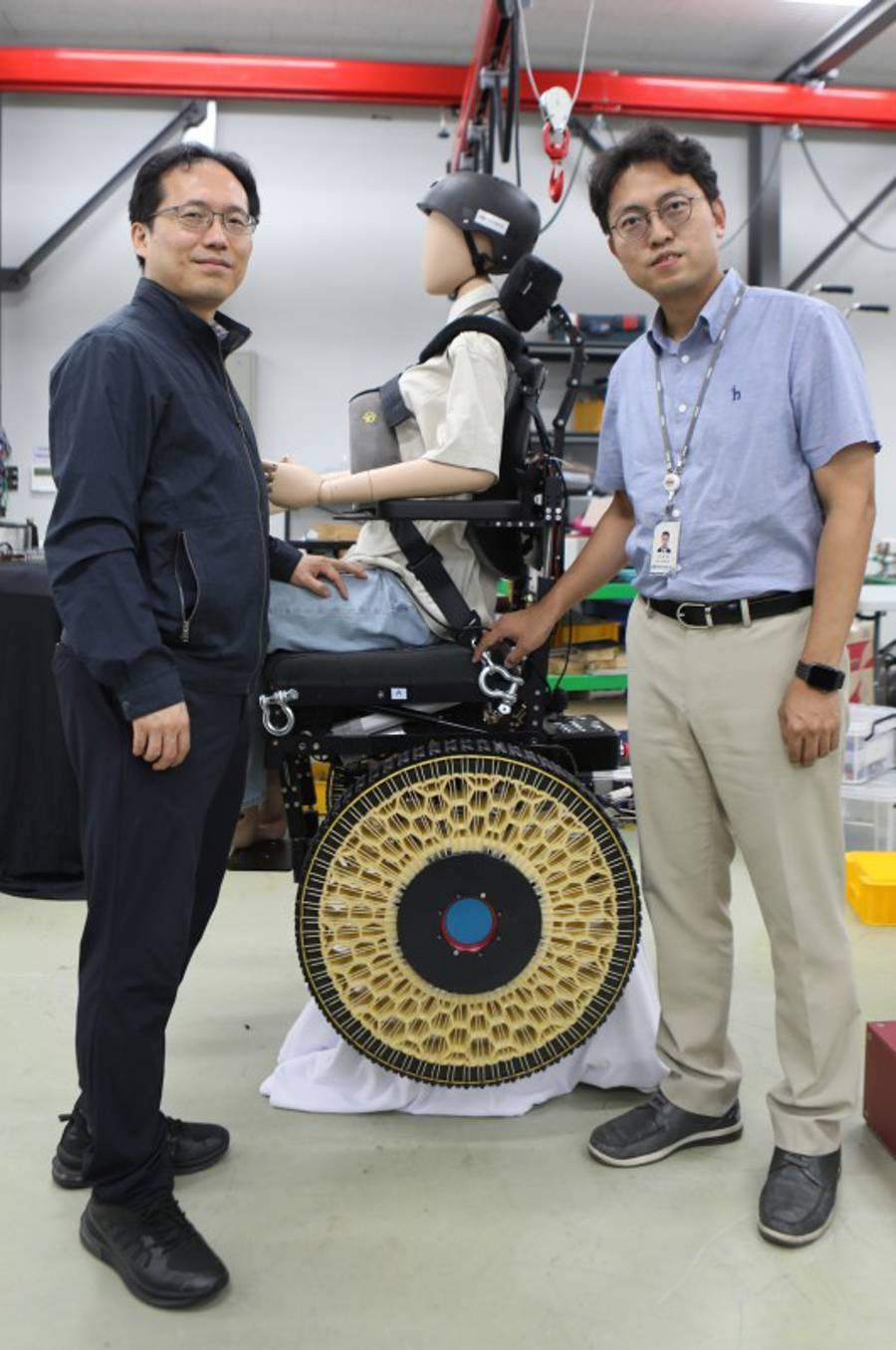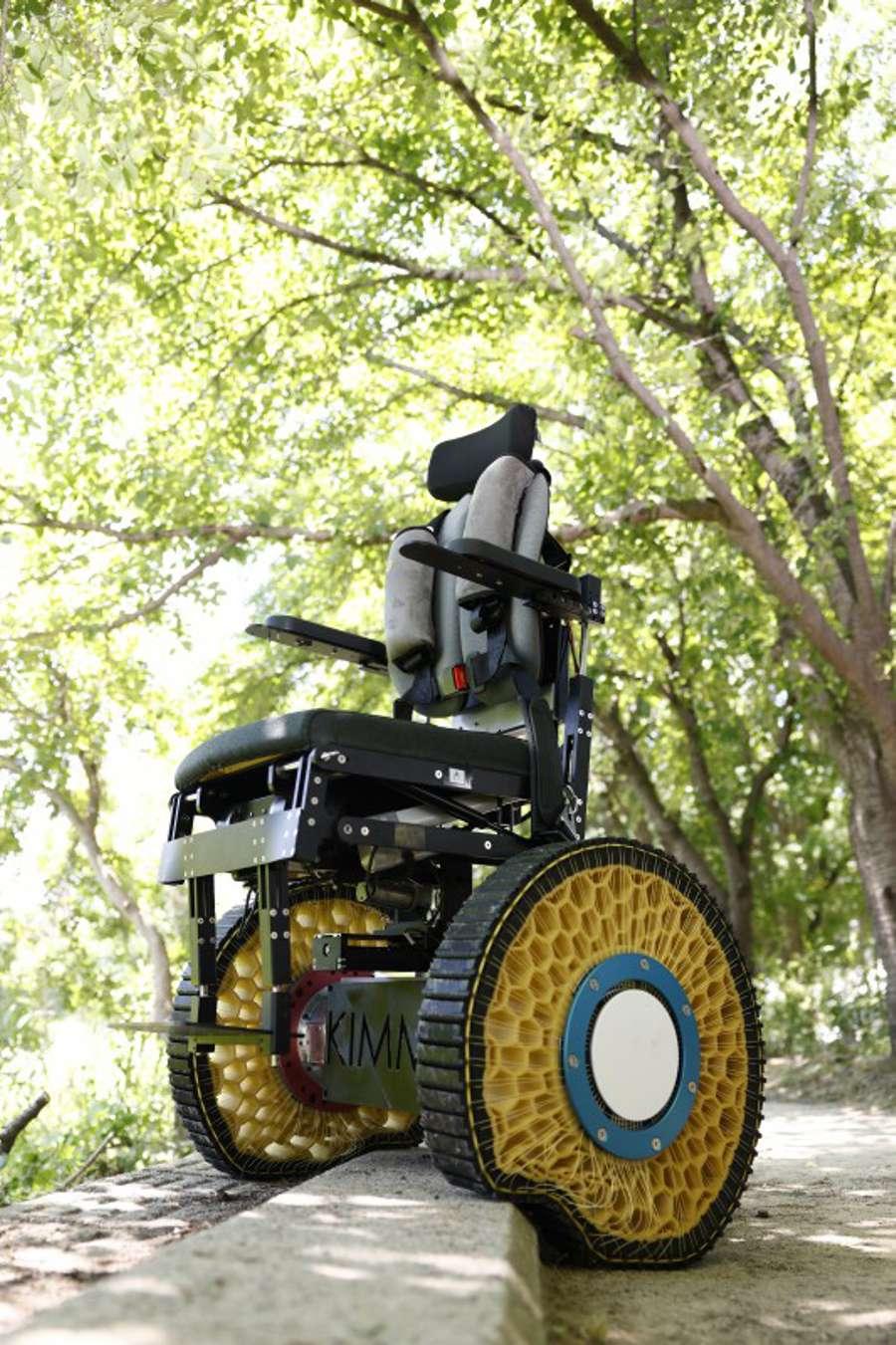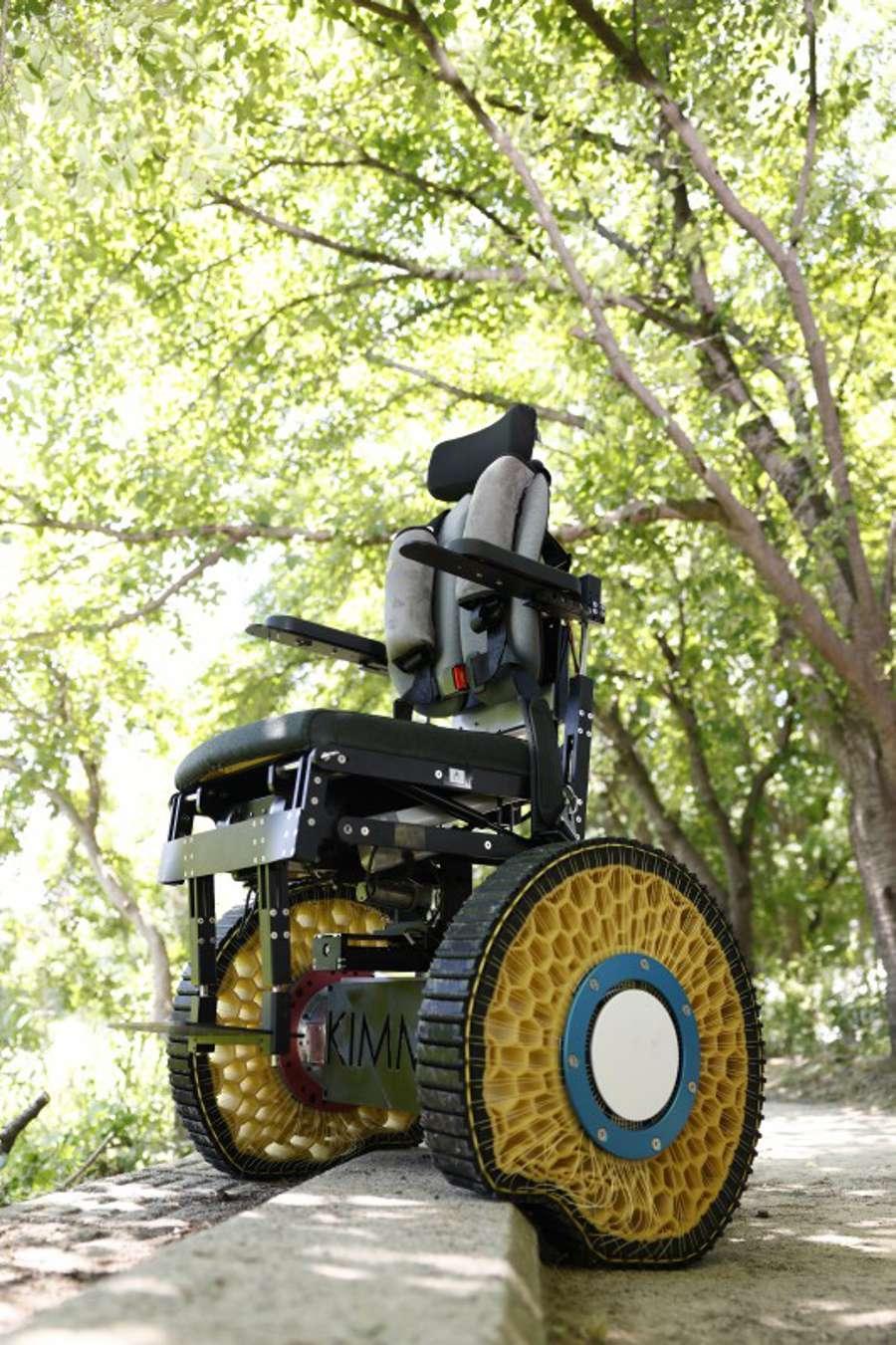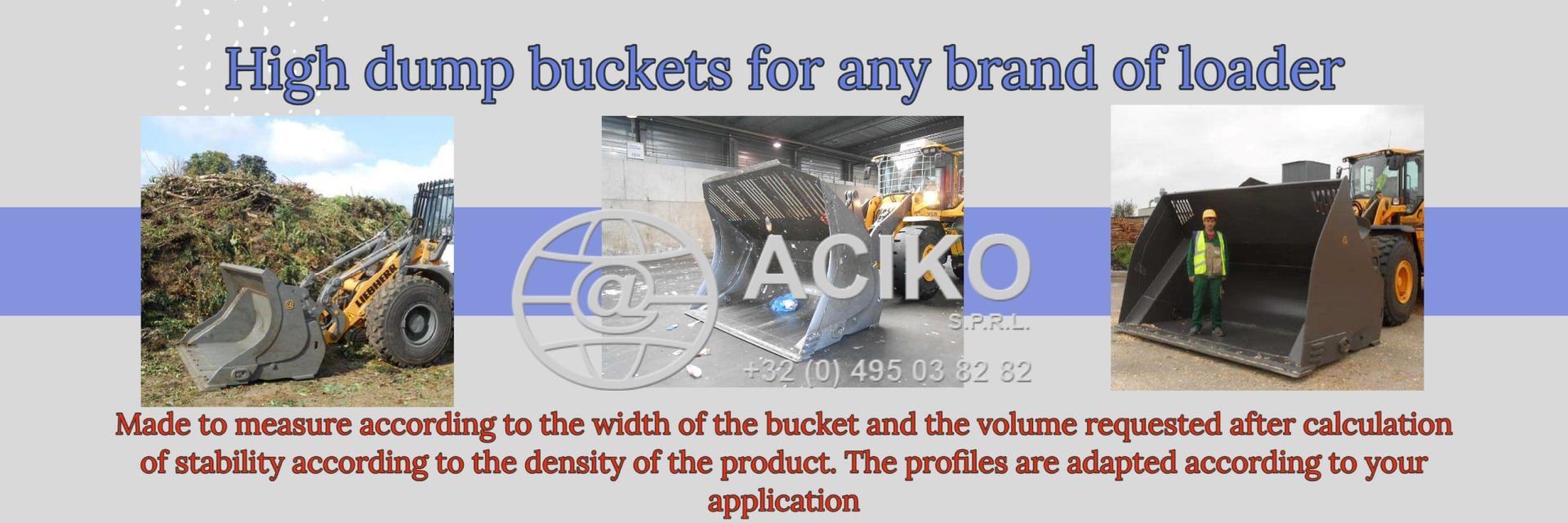R.E.News future Technology-KIMM develops a Variable-Stiffness Wheel that adapts to the Terrain
 06/09/24-FR-English-NL-footer
06/09/24-FR-English-NL-footer
KIMM développe une roue à rigidité variable qui s'adapte au terrain

 Principal Researcher Sung-Hyuk Song (right) and Head of the Advanced Robotics Research Center Dong Il Park (left) at KIMM’s Research Institute of AI Robotics, who developed the variable-stiffness morphing wheel inspired by surface tension. Credit: Korea Institute of Machinery and Materials (KIMM)-A wheelchair featuring the variable-stiffness morphing wheel inspired by surface tension, overcoming an obstacle. Credit: Korea Institute of Machinery and Materials (KIMM).
Principal Researcher Sung-Hyuk Song (right) and Head of the Advanced Robotics Research Center Dong Il Park (left) at KIMM’s Research Institute of AI Robotics, who developed the variable-stiffness morphing wheel inspired by surface tension. Credit: Korea Institute of Machinery and Materials (KIMM)-A wheelchair featuring the variable-stiffness morphing wheel inspired by surface tension, overcoming an obstacle. Credit: Korea Institute of Machinery and Materials (KIMM).
Dans un développement révolutionnaire qui promet de remodeler l'avenir de la mobilité, l'Institut coréen des machines et des matériaux (KIMM) a dévoilé la première roue à rigidité variable au monde, capable d'adapter sa rigidité en temps réel en fonction du terrain.
Cette technologie innovante, inspirée de la tension superficielle d'une goutte de liquide, est sur le point de révolutionner la façon dont les véhicules naviguent dans les obstacles du quotidien comme les escaliers, les rochers et les surfaces irrégulières, ouvrant de nouvelles possibilités pour tout, des appareils de mobilité personnelle à la robotique avancée.
La roue révolutionnaire, développée par le chercheur principal Sung-Hyuk Song et Dong Il Park, responsable du centre de recherche en robotique avancée du KIMM, est conçue pour passer d'un état rigide à un état déformable, permettant aux véhicules de maintenir des performances optimales sur des surfaces planes tout en s'adaptant en douceur pour affronter les terrains accidentés. Cette approche dynamique de la conception des roues marque un écart significatif par rapport aux roues traditionnelles, qui ont souvent du mal à équilibrer flexibilité et stabilité.
Une roue qui change à la demande
La roue morphing développée par KIMM combine une structure de bloc de chaîne intelligente avec un bord extérieur flexible, relié par un système de rayons en fil de fer au moyeu de la roue. La rigidité de la roue est ajustée par les changements de tension de ces fils, imitant la façon dont la tension superficielle d'une goutte de liquide conserve sa forme dans des conditions variables.
Contrôle dynamique de la rigidité : lorsque le moyeu tourne ou change de distance, les rayons en fil de fer se resserrent ou se desserrent, ajustant la tension superficielle du bloc de chaîne intelligent. Lorsque les rayons tirent les blocs de chaîne intelligents vers l'intérieur, la roue se raidit, ce qui la rend idéale pour la conduite sur des surfaces lisses. Inversement, lorsque la tension est relâchée, la roue s'assouplit, ce qui lui permet de se déformer et de s'adapter aux terrains accidentés.
Conception adaptative : cette adaptabilité est non seulement cruciale pour surmonter les obstacles, mais aussi pour maintenir l'efficacité sur les surfaces planes. Contrairement à d'autres conceptions de roues flexibles, qui restent déformées et réduisent la stabilité de conduite, la roue KIMM conserve sa forme lorsque la rigidité est nécessaire, garantissant ainsi un mouvement fluide et stable.
Cette technologie de roue pionnière ne promet pas seulement des performances améliorées pour les véhicules de tous les jours, mais offre également des avantages significatifs pour les applications spécialisées, telles que les fauteuils roulants et les robots, où la manœuvrabilité et la stabilité sont essentielles.
L’impact réel de cette technologie est déjà démontré par son application dans divers systèmes de mobilité, notamment les fauteuils roulants à deux roues et d’autres plateformes mobiles. Une version légère et miniaturisée du mécanisme à rigidité variable a été intégrée à ces systèmes, mettant en évidence le potentiel de la roue à redéfinir notre façon de penser la mobilité.
Fauteuil roulant à deux roues : La roue à rigidité variable permet au fauteuil roulant de se déplacer dans des espaces restreints, de rouler sur des obstacles tels que des rochers et même de monter des escaliers jusqu’à 18 centimètres de haut. Cette adaptabilité permet aux utilisateurs de bénéficier d’un niveau de liberté et de stabilité qui était auparavant inaccessible avec les conceptions de fauteuils roulants traditionnels.
Systèmes mobiles à quatre roues : Lorsqu’elle est appliquée à des plateformes à quatre roues, la roue peut surmonter des obstacles jusqu’à 1,3 fois son rayon, soulignant sa capacité à gérer facilement des terrains difficiles. Cela ouvre de nouvelles possibilités pour les appareils de mobilité personnelle et les robots industriels qui doivent fonctionner dans des environnements complexes.
Le chercheur principal Sung-Hyuk Song a expliqué l'importance de cette innovation : « L'un des problèmes associés aux robots marcheurs quadrupèdes et bipèdes pour surmonter les obstacles est que l'efficacité du mouvement est relativement faible sur les surfaces planes et que des secousses se produisent inévitablement pendant le mouvement. La roue morphing nouvellement développée est particulièrement intéressante dans la mesure où elle est capable de surmonter les obstacles tout en maintenant une efficacité de mouvement élevée comparable aux roues conventionnelles. »
Un bond en avant dans la robotique et la mobilité
Cette avancée va au-delà de l’amélioration des systèmes de mobilité ; elle remet en question les limites des technologies existantes utilisées en robotique et dans d’autres domaines. Les robots à pattes ou à roues conventionnels conçus pour franchir des obstacles sont souvent confrontés à des compromis en termes d’efficacité, de stabilité et de complexité. La roue morphing KIMM, avec son adaptabilité en temps réel, présente une alternative plus efficace et polyvalente.
Dong Il Park, responsable du centre de recherche en robotique avancée du KIMM, a souligné le potentiel plus large de cette technologie : « Cette nouvelle technologie de roues morphing inspirée de la tension superficielle peut aider à surmonter les limites des dispositifs mécaniques conventionnels tels que les robots à pattes et les roues pour surmonter les obstacles. Elle trouvera probablement des applications dans un large éventail de domaines, notamment les fauteuils roulants, les robots mobiles et la mobilité personnelle capable de surmonter les obstacles. »
Au cœur de l’innovation de la roue morphing se trouve sa conception modulaire, qui permet au système d’être facilement intégré dans une variété de plateformes. La structure du bloc de chaîne intelligent, combinée à des rayons en fil de fer, permet à la roue de contrôler précisément sa rigidité sans avoir besoin de capteurs ou de machines complexes.
Bloc de chaîne intelligent : il s'agit du composant clé qui ajuste la rigidité de la roue. Lorsque la tension est appliquée, le bloc de chaîne se comporte comme une roue rigide ; lorsqu'il est relâché, il devient souple et malléable.
Rayons en fil de fer : agissant comme le squelette structurel, les rayons en fil de fer relient le moyeu de la roue à son bord extérieur, contrôlant la tension superficielle et donc la forme et la fonction de la roue.
Cette conception offre non seulement de la flexibilité mais aussi de la durabilité, ce qui rend la roue adaptée à une utilisation à long terme dans divers environnements difficiles. La simplicité du mécanisme lui permet d'être mis à l'échelle et adapté, garantissant son applicabilité dans de nombreux secteurs.
Reconnaissance et perspectives d'avenir
La roue morphing innovante a déjà reçu une reconnaissance significative, faisant l'objet d'un article de couverture dans le numéro d'août 2024 de Science Robotics, l'une des principales revues du domaine. La recherche a été soutenue par un projet visant à développer des solutions de mobilité indépendantes pour les personnes paraplégiques, financé par KIMM dans le cadre de sa mission de promotion du progrès technologique.
En tant qu'institut de recherche à but non lucratif financé par le gouvernement et dépendant du ministère des Sciences et des TIC, KIMM est à l'avant-garde du développement de machines et de technologies matérielles depuis 1976. Son attention continue sur la R&D, les tests et la commercialisation de produits innovants l'a positionné comme un acteur clé dans le paysage technologique de la Corée du Sud.
La technologie de roue morphing de KIMM représente un bond en avant significatif dans la conception de systèmes mobiles, répondant aux défis de longue date dans la façon dont les véhicules naviguent sur divers terrains. Des aides à la mobilité personnelle à la robotique avancée, les applications potentielles sont vastes et variées, promettant d'améliorer l'efficacité, l'accessibilité et la fonctionnalité.
À mesure que cette technologie évolue, il est clair que la roue morphing pourrait établir une nouvelle norme dans la façon dont nous abordons la conception des véhicules, rendant le monde un peu plus navigable, une roue adaptable à la fois.
NJC.© Info KIMM
-------------------------------------------------------------------------------------------------------------------
 06/09/24-English
06/09/24-English
KIMM develops a Variable-Stiffness Wheel that adapts to the Terrain

 Principal Researcher Sung-Hyuk Song (right) and Head of the Advanced Robotics Research Center Dong Il Park (left) at KIMM’s Research Institute of AI Robotics, who developed the variable-stiffness morphing wheel inspired by surface tension. Credit: Korea Institute of Machinery and Materials (KIMM)-A wheelchair featuring the variable-stiffness morphing wheel inspired by surface tension, overcoming an obstacle. Credit: Korea Institute of Machinery and Materials (KIMM).
Principal Researcher Sung-Hyuk Song (right) and Head of the Advanced Robotics Research Center Dong Il Park (left) at KIMM’s Research Institute of AI Robotics, who developed the variable-stiffness morphing wheel inspired by surface tension. Credit: Korea Institute of Machinery and Materials (KIMM)-A wheelchair featuring the variable-stiffness morphing wheel inspired by surface tension, overcoming an obstacle. Credit: Korea Institute of Machinery and Materials (KIMM).
In a ground-breaking development that promises to reshape the future of mobility, the Korea Institute of Machinery and Materials (KIMM) has unveiled the world’s first variable-stiffness wheel, capable of adapting its rigidity in real time based on the terrain.
This innovative technology, inspired by the surface tension of a liquid droplet, is set to revolutionise how vehicles navigate everyday obstacles like stairs, rocks, and uneven surfaces, opening new possibilities for everything from personal mobility devices to advanced robotics.
The breakthrough wheel, developed by Principal Researcher Sung-Hyuk Song and Dong Il Park, Head of the Advanced Robotics Research Centre at KIMM, is designed to shift between a rigid and a deformable state, allowing vehicles to maintain optimal performance on flat surfaces while seamlessly adjusting to tackle rough terrain. This dynamic approach to wheel design marks a significant departure from traditional wheels, which often struggle with balancing flexibility and stability.
A Wheel That Changes on Demand
The KIMM-developed morphing wheel combines a smart chain block structure with a flexible outer edge, connected by a wire spoke system to the wheel’s hub. The wheel’s stiffness is adjusted through changes in the tension of these wires, mimicking the way surface tension in a liquid droplet maintains its shape under varying conditions.
Dynamic Stiffness Control: When the hub rotates or changes distance, the wire spokes tighten or loosen, adjusting the surface tension of the smart chain block. When the spokes pull the smart chain blocks inward, the wheel stiffens, making it ideal for driving on smooth surfaces. Conversely, when the tension is released, the wheel softens, allowing it to deform and adapt to uneven ground.
Adaptive Design: This adaptability is not only crucial for overcoming obstacles but also for maintaining efficiency on flat surfaces. Unlike other flexible wheel designs, which remain deformed and reduce driving stability, the KIMM wheel retains its shape when rigidity is needed, thereby ensuring smooth, stable movement.
This pioneering wheel technology doesn’t just promise improved performance for everyday vehicles but also offers significant advantages for specialised applications, such as wheelchairs and robots, where manoeuvrability and stability are essential.
The real-world impact of this technology is already being demonstrated through its application in various mobility systems, including two-wheeled wheelchairs and other mobile platforms. A lightweight, miniaturised version of the variable-stiffness mechanism has been integrated into these systems, showcasing the wheel’s potential to redefine how we think about mobility.
Two-Wheeled Wheelchair: The variable-stiffness wheel enables the wheelchair to navigate tight spaces, roll over obstacles such as rocks, and even climb stairs up to 18 centimetres high. This adaptability allows users to experience a level of freedom and stability that was previously unattainable with traditional wheelchair designs.
Four-Wheeled Mobile Systems: When applied to four-wheeled platforms, the wheel can overcome obstacles up to 1.3 times its radius, highlighting its capability to handle challenging terrain with ease. This opens up new possibilities for personal mobility devices and industrial robots that need to operate in complex environments.
Principal Researcher Sung-Hyuk Song explained the significance of this innovation: “One of the problems associated with quadrupedal and bipedal walking robots for overcoming obstacles is that movement efficiency is relatively low on flat surfaces, and that shaking inevitably occurs in the moving state. The newly developed morphing wheel is significantly meaningful in that it is capable of overcoming obstacles while at the same time maintaining high movement efficiency comparable to conventional wheels.”
A Leap Forward in Robotics and Mobility
This breakthrough goes beyond enhancing mobility systems; it challenges the limitations of existing technologies used in robotics and other fields. Conventional leg-type robots or wheel clusters designed for obstacle negotiation often face trade-offs in efficiency, stability, and complexity. The KIMM morphing wheel, with its real-time adaptability, presents a more efficient, versatile alternative.
Dong Il Park, Head of the Advanced Robotics Research Centre at KIMM, emphasised the broader potential of this technology: “This new technology for morphing wheels inspired by surface tension can help to overcome the limitations of conventional mechanical devices such as leg-type robots and wheel clusters for overcoming obstacles. It will likely find applications in a wide range of fields including wheelchairs, mobile robots, and personal mobility capable of overcoming obstacles.”
At the core of the morphing wheel’s innovation is its modular design, which allows the system to be easily integrated into a variety of platforms. The smart chain block structure, combined with wire spokes, enables the wheel to precisely control its rigidity without the need for complex sensors or machinery.
Smart Chain Block: This is the key component that adjusts the wheel’s stiffness. When tension is applied, the chain block behaves like a rigid wheel; when released, it becomes soft and pliable.
Wire Spokes: Acting like the structural skeleton, the wire spokes connect the wheel’s hub to its outer edge, controlling the surface tension and therefore the shape and function of the wheel.
This design offers not just flexibility but also durability, making the wheel suitable for long-term use in various challenging environments. The simplicity of the mechanism allows it to be scaled and adapted, ensuring its applicability across numerous industries.
Recognition and Future Prospects
The innovative morphing wheel has already earned significant recognition, being featured as the cover article in the August 2024 issue of Science Robotics, one of the leading journals in the field. The research was supported by a project aimed at developing independent mobility solutions for paraplegic individuals, funded by KIMM as part of its mission to drive technological advancement.
As a non-profit government-funded research institute under the Ministry of Science and ICT, KIMM has been at the forefront of developing machinery and material technologies since 1976. Their continued focus on R&D, testing, and commercialisation of innovative products has positioned them as a key player in South Korea’s technological landscape.
KIMM’s morphing wheel technology represents a significant leap forward in the design of mobile systems, addressing long-standing challenges in how vehicles navigate diverse terrains. From personal mobility aids to advanced robotics, the potential applications are vast and varied, promising to enhance efficiency, accessibility, and functionality.
As this technology evolves, it’s clear that the morphing wheel could set a new standard in how we approach vehicle design, making the world a little more navigable, one adaptable wheel at a time.
NJC.© Info KIMM
----------------------------------------------------------------------------------------------------------------
 06/09/24-NL
06/09/24-NL
KIMM ontwikkelt een wiel met variabele stijfheid dat zich aanpast aan het terrein

 Principal Researcher Sung-Hyuk Song (right) and Head of the Advanced Robotics Research Center Dong Il Park (left) at KIMM’s Research Institute of AI Robotics, who developed the variable-stiffness morphing wheel inspired by surface tension. Credit: Korea Institute of Machinery and Materials (KIMM)-A wheelchair featuring the variable-stiffness morphing wheel inspired by surface tension, overcoming an obstacle. Credit: Korea Institute of Machinery and Materials (KIMM).
Principal Researcher Sung-Hyuk Song (right) and Head of the Advanced Robotics Research Center Dong Il Park (left) at KIMM’s Research Institute of AI Robotics, who developed the variable-stiffness morphing wheel inspired by surface tension. Credit: Korea Institute of Machinery and Materials (KIMM)-A wheelchair featuring the variable-stiffness morphing wheel inspired by surface tension, overcoming an obstacle. Credit: Korea Institute of Machinery and Materials (KIMM).
In een baanbrekende ontwikkeling die de toekomst van mobiliteit belooft te veranderen, heeft het Korea Institute of Machinery and Materials (KIMM) 's werelds eerste wiel met variabele stijfheid onthuld, dat zijn stijfheid in realtime kan aanpassen op basis van het terrein.
Deze innovatieve technologie, geïnspireerd op de oppervlaktespanning van een vloeibare druppel, zal een revolutie teweegbrengen in de manier waarop voertuigen alledaagse obstakels zoals trappen, rotsen en oneffen oppervlakken navigeren, en nieuwe mogelijkheden openen voor alles van persoonlijke mobiliteitshulpmiddelen tot geavanceerde robotica.
Het baanbrekende wiel, ontwikkeld door Principal Researcher Sung-Hyuk Song en Dong Il Park, hoofd van het Advanced Robotics Research Centre bij KIMM, is ontworpen om te schakelen tussen een stijve en een vervormbare toestand, waardoor voertuigen optimale prestaties kunnen behouden op vlakke oppervlakken terwijl ze zich naadloos aanpassen aan ruw terrein. Deze dynamische benadering van wielontwerp markeert een significante afwijking van traditionele wielen, die vaak moeite hebben met het in evenwicht brengen van flexibiliteit en stabiliteit.
Een wiel dat op verzoek verandert
Het door KIMM ontwikkelde morphingwiel combineert een slimme kettingblokstructuur met een flexibele buitenrand, verbonden door een draadspaaksysteem met de naaf van het wiel. De stijfheid van het wiel wordt aangepast door veranderingen in de spanning van deze draden, wat de manier nabootst waarop de oppervlaktespanning in een vloeistofdruppel zijn vorm behoudt onder wisselende omstandigheden.
Dynamische stijfheidscontrole: wanneer de naaf draait of van afstand verandert, worden de draadspaken strakker of losser, waardoor de oppervlaktespanning van het slimme kettingblok wordt aangepast. Wanneer de spaken de slimme kettingblokken naar binnen trekken, wordt het wiel stijver, waardoor het ideaal is voor rijden op gladde oppervlakken. Omgekeerd, wanneer de spanning wordt losgelaten, wordt het wiel zachter, waardoor het kan vervormen en zich kan aanpassen aan oneffen terrein.
Adaptief ontwerp: deze aanpasbaarheid is niet alleen cruciaal voor het overwinnen van obstakels, maar ook voor het behouden van efficiëntie op vlakke oppervlakken. In tegenstelling tot andere flexibele wielontwerpen, die vervormd blijven en de rijstabiliteit verminderen, behoudt het KIMM-wiel zijn vorm wanneer stijfheid nodig is, waardoor een soepele, stabiele beweging wordt gegarandeerd.
Deze baanbrekende wieltechnologie belooft niet alleen betere prestaties voor alledaagse voertuigen, maar biedt ook aanzienlijke voordelen voor gespecialiseerde toepassingen, zoals rolstoelen en robots, waarbij wendbaarheid en stabiliteit essentieel zijn.
De impact van deze technologie in de echte wereld wordt al aangetoond door de toepassing ervan in verschillende mobiliteitssystemen, waaronder rolstoelen met twee wielen en andere mobiele platforms. Een lichtgewicht, geminiaturiseerde versie van het mechanisme met variabele stijfheid is geïntegreerd in deze systemen, wat het potentieel van het wiel laat zien om opnieuw te definiëren hoe we over mobiliteit denken.
Rolstoel met twee wielen: het wiel met variabele stijfheid stelt de rolstoel in staat om door krappe ruimtes te navigeren, over obstakels zoals rotsen te rollen en zelfs trappen tot 18 centimeter hoog te beklimmen. Deze aanpasbaarheid stelt gebruikers in staat om een niveau van vrijheid en stabiliteit te ervaren dat voorheen onbereikbaar was met traditionele rolstoelontwerpen.
Mobiele systemen met vier wielen: wanneer toegepast op platforms met vier wielen, kan het wiel obstakels overwinnen die tot 1,3 keer zijn straal zijn, wat zijn vermogen om uitdagend terrein met gemak aan te kunnen, benadrukt. Dit opent nieuwe mogelijkheden voor persoonlijke mobiliteitsapparaten en industriële robots die in complexe omgevingen moeten werken.
Hoofdonderzoeker Sung-Hyuk Song legde het belang van deze innovatie uit: "Een van de problemen die samenhangt met quadrupedale en bipedale looprobots bij het overwinnen van obstakels, is dat de bewegingsefficiëntie relatief laag is op vlakke oppervlakken en dat er onvermijdelijk trillingen optreden in de bewegende toestand. Het nieuw ontwikkelde morphingwiel is van groot belang omdat het obstakels kan overwinnen en tegelijkertijd een hoge bewegingsefficiëntie kan behouden die vergelijkbaar is met conventionele wielen."
Een sprong voorwaarts in robotica en mobiliteit
Deze doorbraak gaat verder dan het verbeteren van mobiliteitssystemen; het daagt de beperkingen uit van bestaande technologieën die worden gebruikt in robotica en andere vakgebieden. Conventionele robots met poten of wielclusters die zijn ontworpen voor obstakelonderhandeling, kampen vaak met compromissen op het gebied van efficiëntie, stabiliteit en complexiteit. Het KIMM-morphingwiel, met zijn realtime aanpasbaarheid, biedt een efficiënter en veelzijdiger alternatief.
Dong Il Park, hoofd van het Advanced Robotics Research Centre bij KIMM, benadrukte het bredere potentieel van deze technologie: "Deze nieuwe technologie voor morphingwielen, geïnspireerd door oppervlaktespanning, kan helpen de beperkingen van conventionele mechanische apparaten zoals robots met poten en wielclusters voor het overwinnen van obstakels te overwinnen. Het zal waarschijnlijk toepassingen vinden in een breed scala aan vakgebieden, waaronder rolstoelen, mobiele robots en persoonlijke mobiliteit die obstakels kunnen overwinnen."
De kern van de innovatie van het morphingwiel is het modulaire ontwerp, waardoor het systeem eenvoudig kan worden geïntegreerd in verschillende platforms. De slimme kettingblokstructuur, gecombineerd met spaken, zorgt ervoor dat het wiel zijn stijfheid nauwkeurig kan regelen zonder dat er complexe sensoren of machines nodig zijn.
Slimme kettingblok: dit is het belangrijkste onderdeel dat de stijfheid van het wiel aanpast. Wanneer er spanning op wordt uitgeoefend, gedraagt het kettingblok zich als een stijf wiel; wanneer het wordt losgelaten, wordt het zacht en buigzaam.
Spaken: de spaken werken als het structurele skelet en verbinden de naaf van het wiel met de buitenrand, waardoor de oppervlaktespanning en dus de vorm en functie van het wiel worden geregeld.
Dit ontwerp biedt niet alleen flexibiliteit, maar ook duurzaamheid, waardoor het wiel geschikt is voor langdurig gebruik in verschillende uitdagende omgevingen. De eenvoud van het mechanisme maakt het mogelijk om het te schalen en aan te passen, waardoor het toepasbaar is in talloze industrieën.
Erkenning en toekomstige vooruitzichten
Het innovatieve morphingwiel heeft al aanzienlijke erkenning gekregen en werd vermeld als coverartikel in de uitgave van augustus 2024 van Science Robotics, een van de toonaangevende tijdschriften op dit gebied. Het onderzoek werd ondersteund door een project gericht op het ontwikkelen van onafhankelijke mobiliteitsoplossingen voor paraplegische personen, gefinancierd door KIMM als onderdeel van haar missie om technologische vooruitgang te stimuleren.
Als non-profit door de overheid gefinancierd onderzoeksinstituut onder het Ministerie van Wetenschap en ICT, is KIMM sinds 1976 koploper in de ontwikkeling van machine- en materiaaltechnologieën. Hun voortdurende focus op R&D, testen en commercialisering van innovatieve producten heeft hen gepositioneerd als een belangrijke speler in het technologische landschap van Zuid-Korea.
De morphing wheel-technologie van KIMM vertegenwoordigt een aanzienlijke sprong voorwaarts in het ontwerp van mobiele systemen, en pakt langdurige uitdagingen aan in de manier waarop voertuigen door verschillende terreinen navigeren. Van persoonlijke mobiliteitshulpmiddelen tot geavanceerde robotica, de potentiële toepassingen zijn enorm en gevarieerd, en beloven de efficiëntie, toegankelijkheid en functionaliteit te verbeteren.
Naarmate deze technologie evolueert, is het duidelijk dat het morphing wheel een nieuwe standaard zou kunnen zetten in de manier waarop we voertuigontwerp benaderen, waardoor de wereld een beetje beter navigeerbaar wordt, één aanpasbaar wiel tegelijk.
NJC.© Info KIMM
----------------------------------------------------------------------------------------------------------------
Date de dernière mise à jour : 05/09/2024
















